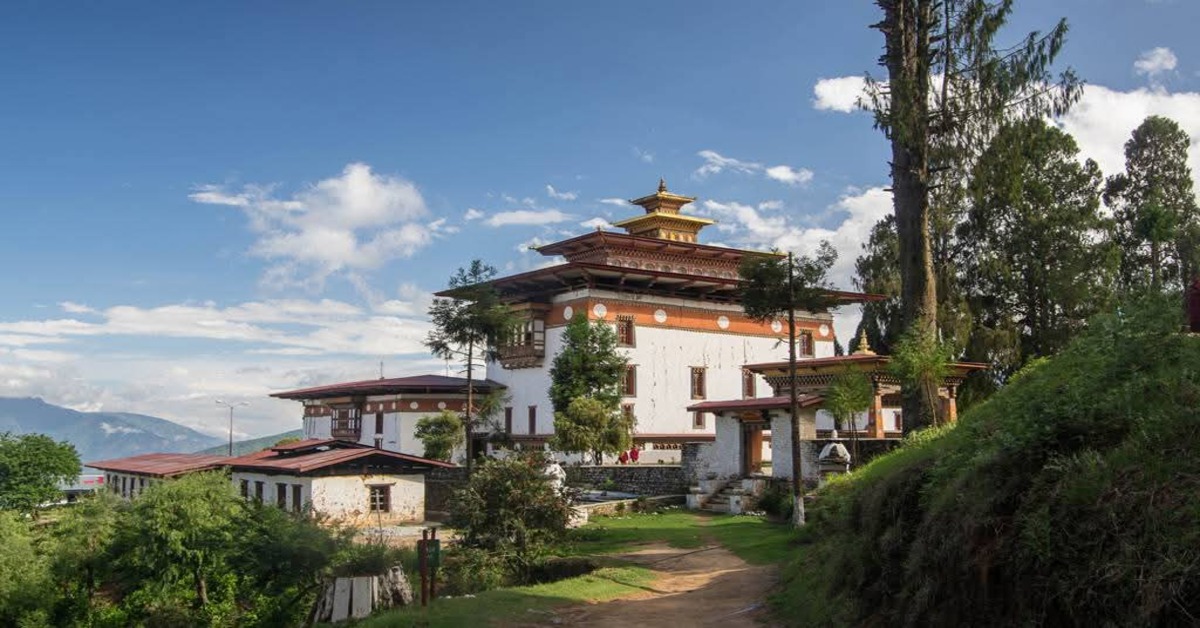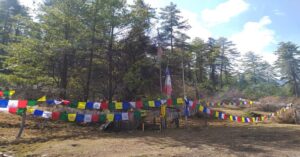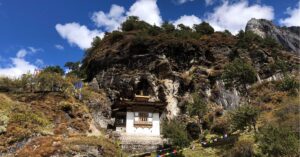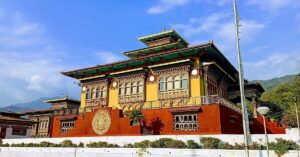Talo Monastery, also known as Talo Sangngak Choling Dzong, is a three-story Drukpa Kagyu monastery built in 1767 by Chogtul Jigme Singye as a replica of the Samye monastery. It served as the seat of Zhabdrung Ngawang Namgyal’s successive mind-incarnations.
Talo Goenpa is the most significant and revered monastery in Punakha Dzongkhag. It is located on a hill at an elevation of 2,800 meters. The monastery is becoming a popular tourist destination, attracting hundreds of visitors to experience the famous Talo Tshechu festival, known for its classical dance performances of Mani-sum. However, tourists can only enter the Goenpa’s courtyard, and access to the monastery remains restricted.
How to Reach Talo Monastery
Talo Goempa is situated on the west side of Punakha Valley, directly north of the Nalanda Buddhist Institute, offering commanding views of Punakha and Wangdue Phodrang. It is a one-hour drive from Khuruthang town in Punakha. This lovely 16-kilometer journey passes by stunning traditional Bhutanese homes and paddy fields. From Punakha town, head north on the main road toward Wangdue Phodrang. After about 10 kilometers, you will reach a fork in the road. Take the left fork, which will guide you toward Talo village. Follow the winding road for approximately 5 kilometers until you arrive at Talo Goenpa, which will be on your right. There is parking available near the monastery.
Talo Goenpa Hike
You can hike to Talo Goenpa from Talo village, which will take around 1 hour. The path is well-marked. Start from the village center, head towards the hills, and follow the signs leading to the monastery. The walk offers beautiful views of the surrounding landscape.
Sacred Relics to See at Talo Monastery
- Sacred Machen of Zhabdrung;
- Statue of Amitayus (Tshepamed);
- Neten Chudruk Lhakhang (Temple of the 16 Arhats);
- Namsey Tsherim, which is publicly displayed only once a year;
- Mani-Sum dance performed during Talo Tshechu.
Historical Significance of Talo Monastery
Talo Dzong or Talo Goenpa was founded in 1767 by Chogtul Gyalse Jigme Singye, the fourth reincarnation of Lam Thripa and the 18th Druk Desi. Jigme Drakpa II, the third mind reincarnation of the Zhabdrung, expanded the Dzong and installed a statue of Pehar from Tibet as the monastery’s guardian spirit, following a precedent set at Samgye in Tibet, upon which Talo was modeled.
He established the precedent of using Talo Goenpa as the main seat of the Zhabdrung incarnations, and it continued to flourish as a spiritual center under Zhabdrung Jigme Norbu, Zhabdrung Jigme Chhogyal, and Zhabdrung Jigme Dorji.
Description of Talo Monastery
The location exudes a cozy vibe, with a few hermitages scattered throughout. Buildings are oriented southeast in alignment with the lay of the land.
The central organizing structure is a three-story Lhakhang surrounded by a ring of prayer wheels. Its gently tapering, white-washed walls are interspersed with rows of small windows and a prominent red khemar band near the cornice. Although the khemar bands of great Goembas are typically decorated with gold and copper medallions representing the sun and the moon, blank white disks are used instead. Above these, the roof of the Lhakhang is fashioned in the four-cornered, multi-tiered Jabzhi style, topped with a gilded Sertog finial.
The Lhakhang is large enough to effectively serve as a utse (central tower), around which the remainder of the monastery is organized. The living quarters and ancillary functions are wrapped in a U-shape around the tower, creating a sheltered courtyard. Southeast of the main compound is a series of terraces descending the hillside, the nearest of which is occupied by a small white Chorten overlooking the valley.
There are many Lhakhangs and statues inside the monastery, one of which is the Neten Chudru Lhakhang and the other the Tshepamed Statue. Below the Tshepami statue is a Namsey Tsherim sealed for public display. The inner walls of the monastery are painted with Zhabdrung’s images, substituting 10,000 Zhabdrung statues. The powerful deity of this three-storied monastery is Gyelchen Kuentu Zangpo, also known as Talo Gyep.
Talo Shedra
A Shedra, or the Buddhist educational institute, has operated since 2000 and is home to 105 monks of 7 to 26 years of age.
Talo Tshechu Festival
Talo Monastery has held a three-day festival every year for over 300 years. The celebration is renowned for its captivating mask dances and classical performances. Zhabdrung Jigme Drakpa II instituted the annual Tshechu festival of Talo Goenpa.
Talo Tshechu is popular for its three sacred classical songs called Mani-sum, exclusively performed by the Talo women’s dance troupe. Manisum was composed by Meme Sonam Dhondup, the grandfather of Zhabdrung Jigme Chogyal, the fifth mind reincarnation of Zhabdrung Ngawang Namgyel. The Mani-sum is hand-written on old scrolls and has been handed down through the ages, without changing its tune or lyrics. It is now registered as a property of the Talo monastery. A distinctive aspect of Mani-sum is that only residents of Talo, known as Talops, are permitted to learn the songs.
Each day of the Talo Tshechu festival concludes with the rendition of the three songs called Mani-sum. Samyeki Salang is performed out of the three songs on the festival’s first day. It is believed to have been originally composed to celebrate the construction of the Talo Goemba, which is regarded as a replica of the Samye Monastery of Tibet built in the 8th century.
Drukpai Dungye is performed on the second day. The song narrates the story of the Zhabdrung Lineage. On the third and final day, Thowachi Gangi Tselay is performed as a song of gratitude.
Best Time to Visit Talo Monastery
The best time to visit Talo Goemba is during the spring (March to May) and autumn (September to November) seasons. The weather is pleasant, the skies are clear, and it’s perfect for outdoor activities and sightseeing. However, the ideal time would be during the famous Talo Tshechu festival, which falls in spring. You can visit major pilgrimage sites of Punakha with the Bhutan Pilgrimage Package.
Places to Explore in Punakha
Punakha Dzong: Also known as Pungthang Dechen Phodrang Dzong or “the palace of great happiness or bliss,” it is a majestic structure located in Punakha, Bhutan. It was constructed by Zhabdrung Ngawang Namgyal in 1637-38 and is the second oldest and second largest dzong in Bhutan.
Chimi Lhakhang: Also known as the fertility temple, it is a Buddhist monastery in Punakha. It was constructed on the site where Drukpa Kunley subdued a demoness. The monastery was founded in 1499 by Lam Ngawang Chogyal.
Goen Tshephu Ney: This is a sacred cave of longevity in Punakha, considered the third Draphu Maratika. Guru Rinpoche meditated in the cave for three months and visualized Buddha Amitayus, the “Buddha of Long Life”.
Chubu Tshachu: Also known as Chuba Tsachu, it is a well-known hot spring in Punakha. The hot spring is said to have been discovered by Guru Rinpoche in the 8th century. Chubu Tshachu is helpful with cold disorders, chronic stomach aches, diabetes, and indigestion.
Kabji-Hoka Tsho: It is a sacred lake in Punakha with an opening in the lake created by the lake’s deity after a demon threatened to flood the area. The hike to Kabji-Hoka Tsho is considered to be of medium difficulty. It takes two to three hours on foot from Chorten Nyingpo Lhakhang.
Punakha Suspension Bridge: The bridge is one of the country’s longest suspension bridges, spanning approximately 180 meters over the Pho Chhu River. The bridge connects Punakha Dzong with Punakha town and nearby villages.
Khamsum Yulley Namgyal Chorten: This is a Buddhist Stupa in Punakha on a hilltop overlooking the Mo Chhu River, constructed in 1992 to ward off evil spirits and to bring peace and harmony to all living beings.
Enjoyed reading this blog?




